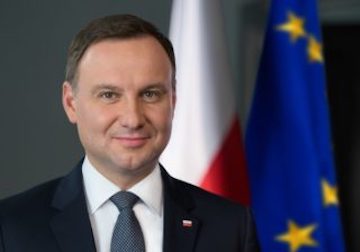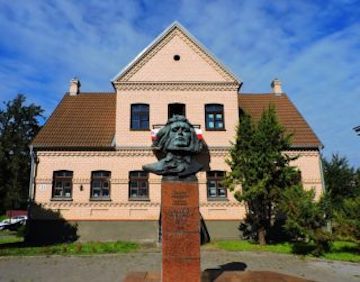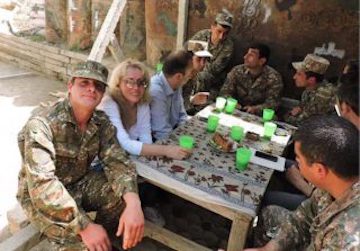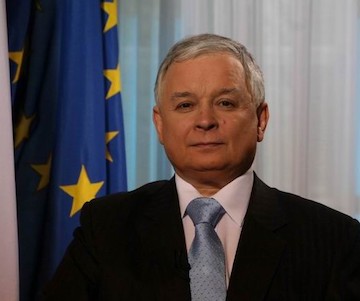Polish ambitions in global politics in 2017
 Print This Print This
By Alla Pierce, Veterans Today
Veterans Today
Friday, Jan 13, 2017
 |
| Polish President Andrzej Duda |
While the world’s attention is focused on the key players in global politics, the other players tend to take a more defined position in their regions. For a long time Poland has conducted a competent, well-planned and quite successful policy on spreading its influence over the countries of the former Socialist bloc.
In 2006 a project was launched called “Poland from sea to sea”, implying that “the peoples of the Federation under the control of Poland should be extended” from sea to sea “, that is, from the Baltic to the Black Sea.”
In fact, such a project had already been put forward by Jozef Pilsudski after the First World War. And probably every Polish ruler dreamed about the revival of the Rzeczpospolita or any embodiment of it, but with the broadest maximum historical borders.
The President of Poland Andrzej Duda also stated his support to create a block of states from the Baltic to the Black Sea. This is understandable. If he didn’t, then he wouldn’t have achieved his position.
Many different programs operate within the frame of this project. The term “Small Polschizna” appeared and implicates the lands that border with Poland, where a significant number of ethnic Poles reside. Very active work takes place in the creation, development, to make the Polish religious-cultural environment predominant in these areas.
Look at the website “Polish Aid”. You can see the map that shows the countries that are a priority for Poland, such as: Belarus, Ukraine, Moldova and Georgia. These are the most important geographical points of reference for the implementation of project “from sea to sea.” There are programs that are used to work with these countries.
However, we can only guess at what projects lie within the scope of “assistance to Ukraine” where training was given to fighters for the Maidan in military camps on the territory of Poland, as repeatedly stated by a member of the Euro parliament Janusz Korwin Mikke (Janusz Corwin Mikko).
Training and financing opposition in the above-mentioned countries, with an aim to disrupt the normal way of life, sew discord and chaos, lies the contradictions and hatred within countries on the principle of “divide and rule” and is only one side of the Polish-setting activities of its influence. At the same time the work on Polonisation of the population of these countries is gently but meticulously being carried out.
Although Poland seems to be far away from Moldova and Georgia, Warsaw has interests over there, and it shows. In Moldova, for example, Poland supports the establishing of information centers for local authorities, where they are taught how to conduct a “real democracy” in their country.
Georgia has a relatively high number of Poles that live there, caused by various historical events. So, in this country, the Union of Poles in Georgia, Polish Educational Center, polish school and other different fellowship, centers and associations successfully operate.
 |
| Union of Poles, Grodno |
In Belarus, the situation is different. There are many Poles living in this country. In Grodno province, Poles make up about a quarter of the population. So, in RB active work winning people’s hearts and minds by Poland is intensively carried out towards all prospective age groups, and in all fields: educational, cultural, economic and information.
At the same time, Catholic churches suddenly began opening in the eastern regions of Ukraine in places where the Polish population is low.
I am receiving personal e-mail messages with information that in the cities of the eastern part of Ukraine catholic churches began holding services in Polish, using speakers, so the resonant voice of the Catholic faith is heard widely across the area. And this is where very few Polish people live. Poland supported, financed, and trained those “innocent students” in Polish military bases.
Although the talks about returning four Ukrainian regions back to Poland was initially conducted since the first days of the Maidan uprising, they were not very focused or affirmative. Now the project “Ukraine” goes right to the end. The goal was reached: now Russians kill Russians. The Russian Federation has an armed aggressive enemy on its borders. Whatever could be stolen in Ukraine has already been stolen. Warsaw had its interests in this game and the time is now to achieve its goals.
 |
| Alla with Armenian soldiers during the recent fighting with Azerbijan |
In this regard, it seems no coincidence that the movie “Volyn, directed by Wojciech Smarzowski which dramatically increased the degree of hatred for Ukrainians was released now. The Volyn tragedy is one of the most terrible pages of history.
It has to be remembered by both Poles and Ukrainians in order to prevent this happening again. But why was this movie released now? Why for so many years Poles didn’t talk about that hellish chapter, through which their fellow compatriots perished?
This link is to the article that describes 362 ways that Ukrainians murdered Poles and other nationalities. Hairs will stand on end when you begin to read it.
At the same time we can’t help not to ask the question: how is it that the young generation of Poles do not know about these atrocities perpetrated in 1943? Maybe because they didn’t need to know it in order to support the Ukrainian Maidan uprising and fueled by Russophobic propaganda? How many Polish mercenaries fought and are still fighting in the Donbass?
During my trip to the frontlines, I was told by some Donbass defenders about the horrors Polish mercenaries do to prisoners of war. Who are these Poles who, encouraged by Bandera’s slogans, disembowel living humans in the Donbass because of their hatred towards Russians?
Why are the descendants of those who suffered the most brutal sadistic genocide taking part in the genocide of the Russian people in Donbass under the same slogans and banners, under which their compatriots were massacred?
Aside from the emotions, we can state that major political actions preceded the formation of public opinion. In July 2016 the decision of the Polish Sejm adopted a resolution on the recognition of the Volyn tragedy as genocide carried out by Ukrainian nationalists against Polish citizens and established a National Day of Remembrance of the victims.
This decision creates the legal basis for filing compensation claims and returning lands. The first lawsuits have already been filed. Ukraine has no money but still has the territory. [1]
Why would Poland need the problematic areas of Ukraine, even as compensation? Just because in one period of history it belonged to Poland? As the matter of fact those lands were not always Polish. For example, Lvov, which Polish people consider their own city, was named after the son of the Galician-Volyn prince.
Why would Poland, whose economy survives on subsidies from Brussels want to head Intermarum and take responsibility and shoulder the region with economic problems, aiming to become a key player in this region?
The world’s largest global project is a new Chinese Silk Road, One Belt One Road, bearing investments and benefits from trade and transit to countries through which it passes. Look at the maps.
The Baltic countries, Moldova, Georgia, Belarus, Ukraine, and Slovakia – all Intermarum countries could be involved in this large economic project. We can see on the map the favorite Polish city of Lvov as the one of the points on OBOR.
For the key players who will manage and control the region, this presents not only economical possibilities, but also opportunities to influence the process of global politics.
Today, one of the objectives of Warsaw, integrated into a global policy of Washington is cutting off the EU market from the Russian Federation and furthermore to prevent the creation of a Russian-German union, aiming to weaken Russia by any means.
Therefore, while Poland is taking the vassal of the US position, it will always put a dent in the works of any projects contributing towards the development of Russian-European relations, even to the detriment of its own national interests.
 |
| Lech Kaczynski |
Polish politicians who elect a more constructive way of development for their country and stand for closer ties with the Russian Federation end up getting suppressed one way or another.
The death of the Polish politician Andrei Lepper, the leader of “Self-defense”, was not accidental, as well as the arrest of Mateusz Piskorski, right before the NATO summit. He stands for good neighborly relations with surrounding countries and requires Poland getting out of NATO and threatened to publish a book about the murder of Andrei Lepper.
There is also an interesting version of events regarding the death of President Lech Kaczynski in an airliner crash over Smolensk as most likely another “false flag operation”, which occurred after Kaczynski, who used to be a rabid Russophobe, evolved towards rapprochement with Russia. Kaczynski, for all his negative aspects, stubbornly defended Polish national interests.
The plane crash over Smolensk is an obvious “false flag operation”, but the liquidation of an “uncomfortable” president is not more than just a “bonus” to the real motivation and goals of this operation. However, with an absence of irrefutable evidence, each version of events has its own right to exist, as well as the one in which the pursuit of sovereignty can be paid by losing one’s freedom and life, especially for those who act for a rapprochement with Russia, or to support, oh My God, the dictator Lukashenko, as Andrei Lepper did.
Would Poland be able to achieve regional leadership? The experience of the Visegrad Group shows that this is quite doubtful, given the contradictions between these countries.
Besides, the strengthening of militarist rhetoric of the Polish government orchestrated from overseas and the destructive policy in relations with Russia do not coincide with the interests of the countries of the potential Intermarum.
For instance, Moldova, in which Poland seeks to increase its influence determines its course of integration with the EAEC and Non NATO as we can see after the recent elections.
The West doesn’t need a strong Poland. It certainly received a green light for the destruction of Ukraine and Belarus, and its participation in the expulsion of Russia from the Black Sea region and its role in the distribution of Russophobic attitudes is encouraged. However, through purchasing power and influence in the region, Poland will increasingly act in its own national interests which will be considered a threat by its masters of today.
Besides, a significant sector of Polish people, as we could see during recent protests in Warsaw, do not support their own government.
The failed Polish “Maidan” showed how strong contradictions are in Polish society. The political opposition in government and the public opposition on the streets have their differences. Nevertheless, with this level of internal problems the situation in the country can hardly be called healthy. Taking into account external and internal reasons the geopolitical appetite of Poland will highly unlikely be fully satisfied.
________
[1] In the past, Poland has repeatedly speculated on its own compatriots’ protection in an order to achieve its geopolitical ambitions. On March 17, 1938, Poland issued an ultimatum to Lithuania with the requirements of a convention, which guarantees the rights of the Polish minority in Lithuania. If the ultimatum was rejected Poland threatened to occupy the whole of Lithuania within 24 hours.
On the 21-22 September 1938 – Poland sent a note to Czechoslovakia with a demand to solve the problem of the Polish minority in Cieszyn Silesia and then an ultimatum about adding the land with the Polish population to Poland. In October 1, 1938, Czechoslovakia ceded to Poland a region where the Czech population was 60%. “Operation Zaluzha” began on October 2, 1938. Poland occupied Cieszyn Silesia and some settlements in the territory of present-day Slovakia.
Source URL
|
 Print This Print This

|

